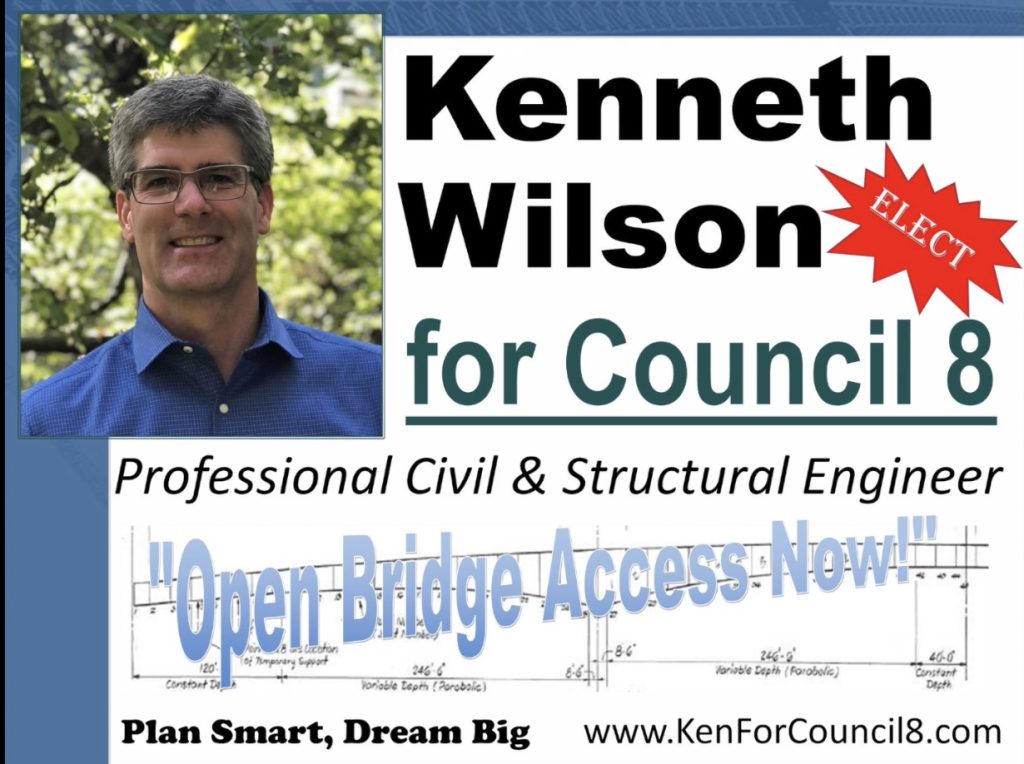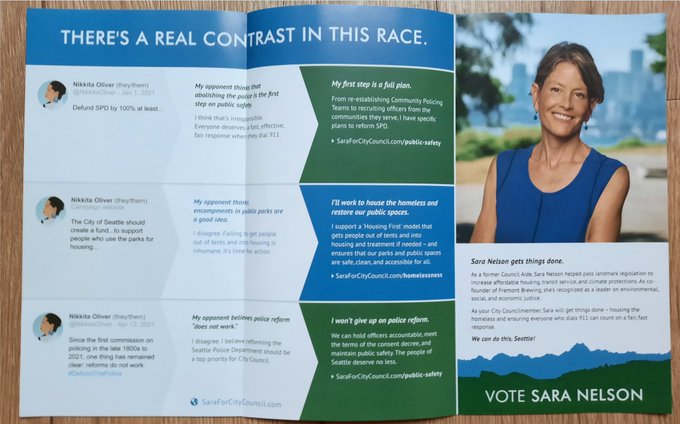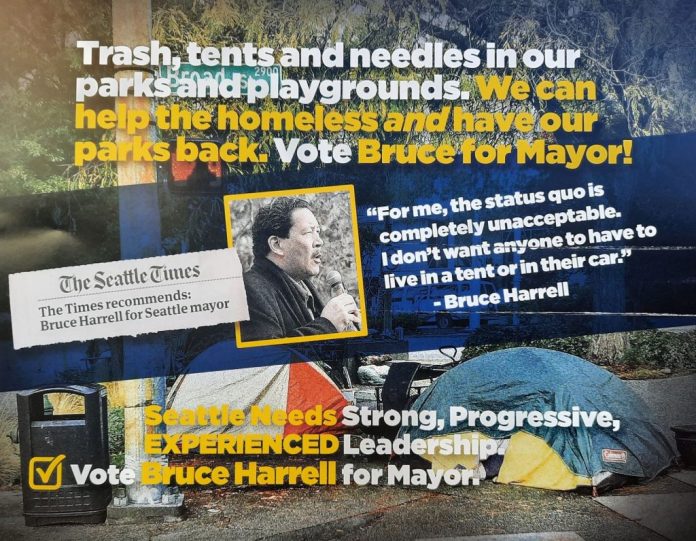Recently, I got called out in a discussion where I labeled something a “bad faith” argument. We were talking about the last Seattle City Council election between Dan Strauss and Heidi Wills for District 6. I said one reason it was wholly appropriate Wills lost because she made a bad faith argument that the Burke-Gilman Trail Missing Link should be replaced with an elevated bikeway. Someone took me to task on labeling Wills’ concept — and by extension Wills — was acting in bad faith.
A bad faith argument is one thrown out to obscure a hidden agenda, coming to the negotiation table with no intent of reaching an outcome. Tossing off lazy words about an elevated bike lane carries a hidden agenda of torpedoing the project. Seattle is notoriously cheap when it comes to bike infrastructure and the Missing Link has been the most contentious segment of the Burke-Gilman Trail for decades now. Make it more expensive? That’s trying to dunk the whole thing.
But does it rise to the level of bad faith? Or was the idea simply disingenuous, something that was an insincere solution to an honest argument. Wills spent time on the city council, and more than a second paying attention would inform her that any bike lane was contentious, much less one at ten times the price. But she was engaging in the discussion about the Burke-Gilman Trail. A bad faith argument would not have gotten that far.
Disingenuous arguments versus bad faith arguments. They’re both misrepresentations. But the focus of the lie is different. And its impact on the listener is different. Those are vital as we come into the final days of this election, where misinformation abounds.
The focus: it’s not me, it’s you.
Disingenuous arguments are a lie about the person making them. It’s being dishonest that the person making them is capable of seeing complexity in the situation.
A good example of this is the City Council Position 8 race. Candidate Kenneth Wilson proposes to re-open the West Seattle Bridge before it’s structurally fit. His solution includes shaving down the bridge’s concrete barriers and opening one lane in each direction to cars. From his website, “I have difficulty understanding that with 100,000 vehicles per day why the West Seattle Bridge had not been similarly prioritized for some level of opening.”

It is a disingenuous argument because it engages the debate about the bridge on legitimate terms, then misrepresents Wilson’s ability to come to grips with the complexity of the situation. As an engineer, he’s fully capable of recognizing that more goes into the decision to reopen a bridge than just the weight it carries. There’s traffic diversion, enforcement, monitoring, and completing further repairs. As well as the outstanding question of what if the calculations are a little off and the bridge collapses with people on it? Competent engineers can recognize the peril.
Compare that to the underlying misrepresentation of a bad faith argument. It’s a lie against the discussion itself and you, the listener, for thinking that the issue is important. Bad faith arguments are just to occupy the debate and turn it into an energy sapping argument. Bad faith goes beyond straw men and red herring debate stylings because it’s not a rhetorical device. It’s a straight up attack on having the discussion.
The impacts: false hope or violent anger.
Deeper, the two arguments have different impacts on the people hearing them. Disingenuous arguments give hope, albeit false. Bad faith arguments spur violent anger. We can see the difference in one of Seattle’s most pressing debates, what to do for those experiencing homelessness.
Now, we know what it will take to address homelessness in King County and Seattle. It’s a billion dollars of affordable housing and the political will to build it. Getting people into those homes requires attacking the root causes of homelessness, most pressingly poverty and racism. Anything short of those two things is a misrepresentation of the actions we must take.
Vigilante sweeps group We Heart Seattle has a number of failures. And their perspective — that it just takes grit and a few trash cans to solve homelessness — is demonstrably false. But their disingenuous message is a hopeful one. Homelessness is easily solvable. We all just need to roll up our sleeves and get ‘er done.
To those who pay attention, We Heart Seattle’s got a trail filled with with misrepresentation and broken promises. But listening to their supporters suggests a level of hope. Disingenuous arguments have a generally positive impact on the listener. Hey, we can build the Burke-Gilman Trail Missing Link, at ten times the price and raised from the ground. Hey, we can reopen the West Seattle Bridge if we kind of ignore safety and liability. Hey, we can solve homelessness with just a bit more can-do spirit.
The flip side is the “Compassion” Seattle arguments that those experiencing homelessness should be jailed, involuntarily committed to an asylum, or kicked out of town. On its dishonest surface, the proposal was to force funding from the city, but the backstop was always expulsion. It is a bad faith attack on the discussion itself. First, labeling it compassionate is a lie. Second, homelessness is not a crime, so expulsion and incarceration are not solutions for it. Third, the main proponents have regularly stood in the way of making real progress on raising resources or creating policies that actually address homelessness. A proposal of jail, asylum, or GTFO is an attack on the very discussion of homelessness because it is saying the problem won’t be there if we just put Them away or send Them out of town. No homeless? No problem!

Similar to I Heart Seattle’s message of community togetherness, the compassionate conservative message is a simple knife through the Gordian knot of a problem. But as a bad faith proposal, the impact lands different.
Those hearing the bad faith compassionate conservative argument are not getting the message that homelessness can be solved. They’re receiving anger. Anger that no one’s “strong enough” to solve homelessness. Anger that someone else is getting something they are not. Anger that The Unworthy are taking up their parks. It’s a January 6th style of rage, violent in its delivery and obstinate that there are any other alternatives.
Unfortunately, it’s a platform that’s been adopted by the Position 9 council candidate and the Seattle Mayor candidate that were not endorsed by The Urbanist Elections Committee. Their flyers feature a city on fire. Their television commercials slow pan over tent encampments. Their announcements feature the backdrop of anger towards anyone who thinks this discussion needs to be more than expulsion. It is a continual message of fear to stoke anger that we are even having this debate.
In speaking with people during get out the vote door knocking, I have heard this rage among their supporters. Frosty distance aside, many Seattleites will engage in an informed and even pleasant discussion of the coming election. But once a yard sign goes up for one of the “compassionate” candidates, it is anger, full stop.
The future: not this mayor.
Which brings us to the oblivious ramblings of our current mayor. After waving off her responsibility for chemical bombing downtown neighborhoods and failing to enforce a police consent decree she helped draft, she’s moved to asking we not believe our own damn eyes. This week, Durkan said she knew nothing about any sweeps. The city had not forcibly removed people from their homes because they’d been offered relocation.
Sweeps are sweeps, regardless of Durkan’s attempt to rewrite her legacy. Suggesting her obligatory throwing of a few underpaid navigation folks out to make a cursory offer of the magic ticket to an underprepared shelter somehow absolves this from being a sweep is a giant middle finger as Mayor Jenny heads out the door.
But the fact is the city’s most photographed and discussed encampments — Third Avenue, Bitter Lake, Ballard Commons — are being publicly ignored adjacent to somewhat strategic places. Set up for arguments about “safe for families.” Easily filmed for campaign commercials. Right next to television network studios and ballot boxes. Is this disingenuous or bad faith?
Neither. It’s an exclamation point on four years of mismanagement. And it’s begging an electorate to call out nonsense and vote for something other than lies.
Ray Dubicki is a stay-at-home dad and parent-on-call for taking care of general school and neighborhood tasks around Ballard. This lets him see how urbanism works (or doesn’t) during the hours most people are locked in their office. He is an attorney and urbanist by training, with soup-to-nuts planning experience from code enforcement to university development to writing zoning ordinances. He enjoys using PowerPoint, but only because it’s no longer a weekly obligation.


